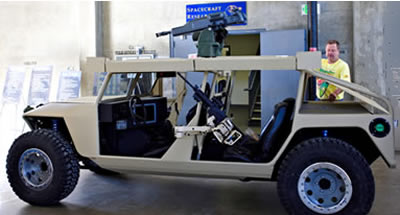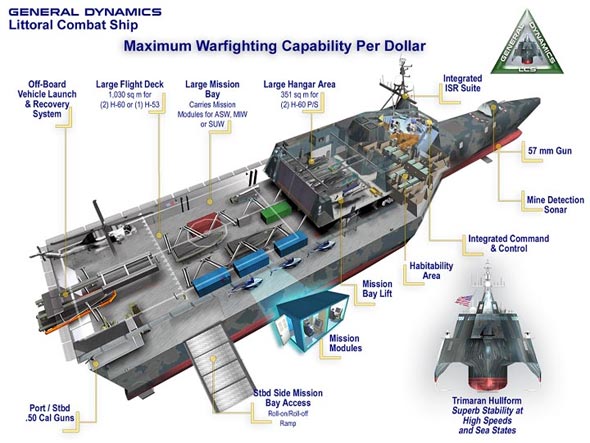
 One of the newcomers at DSEi, Modern Day Marine and AUSA 2007 expos was the Grizzly from the US company Blackwater. Originally developed to meet the company’s requirements for secure transportation in high threat areas. The vehicle uses a unique ‘diamond hull’ design that consists of a V shaped hull and sloped walls, offering protection against both roadside bomb and under-belly attacks. The vehicle’s armor is made primarily of layered steel plates, combined with air gaps and layered composites to mitigate blast and behind-armor effect. Providing an enhanced protection against advanced threats including EFPs, Grizzly is one of the contenders for the US Marine Corps Mine Resistant Ambush Protected (MRAP II) program. It is also being considered for the British MPPV program.
One of the newcomers at DSEi, Modern Day Marine and AUSA 2007 expos was the Grizzly from the US company Blackwater. Originally developed to meet the company’s requirements for secure transportation in high threat areas. The vehicle uses a unique ‘diamond hull’ design that consists of a V shaped hull and sloped walls, offering protection against both roadside bomb and under-belly attacks. The vehicle’s armor is made primarily of layered steel plates, combined with air gaps and layered composites to mitigate blast and behind-armor effect. Providing an enhanced protection against advanced threats including EFPs, Grizzly is one of the contenders for the US Marine Corps Mine Resistant Ambush Protected (MRAP II) program. It is also being considered for the British MPPV program. 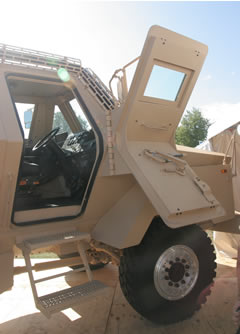 The vehicle’s diamond hull shell is attached to a Seagraye chassis, powered by a 330 hp caterpillar C7/3126E turbo-diesel engine. The cab and body are separate and can be removed and installed on the chassis within eight hours. The vehicle has a gross vehicle weight of about 15 tons (30,000 lbs). It can accommodate 8-10 soldiers and the driver seated in blast protected seats or on benches. It is fitted with side, front and rear replaceable armored windows, and multiple firing ports.
The vehicle’s diamond hull shell is attached to a Seagraye chassis, powered by a 330 hp caterpillar C7/3126E turbo-diesel engine. The cab and body are separate and can be removed and installed on the chassis within eight hours. The vehicle has a gross vehicle weight of about 15 tons (30,000 lbs). It can accommodate 8-10 soldiers and the driver seated in blast protected seats or on benches. It is fitted with side, front and rear replaceable armored windows, and multiple firing ports.
Blackwater Grizzly
SRATS – Stealth Reconnaissance/Assault Transport System
SRATS which stands for “Specialized Reconnaissance Assault and Transport System” evolved from a proof of concept vehicle, utilizing “Rock Crawler” and “Sand Rail” technologies, which are popular with recreational and extreme off-road automotive sports, to produce an off-road vehicle designed to handle extreme terrain conditions. In 2004 DARPA funded the development of two prototype vehicles under a proof of concept demonstration of a small vehicle which would bridge the gap between the soldier and the HMMWV. At AUSA 2007 BAE Systems and the SRATS developer specialty vehicle maker unveiled their cooperation in transforming the militarized rock crawler into serially produced military vehicle, responding to the US Army’s interest in fielding thousand of vehicles to support its light brigades and special forces. 
As an automotive platform designed for mobility in extreme conditions, SRATS combine commercial ‘rock crawlers’ and sand rail technologies, enabling near vertical rock climbing or rubble field traverse (maximum grade climb of 80%). The vehicle also has high acceleration and speed, sustaining high speed chase or fast egress from a hot target area.
The vehicles went through field testing and demonstrations beginning November 2004. The demonstrations simulated reduction of soldier load (backpack) by 80 per cent or more and infantry logistical support going anywhere a soldier can walk or climb. The vehicles demonstrated their capability of handling extreme terrain, traveling over rubble and going through road-less terrain. They were tasked with simulated high-speed convoy escorts, casualty evacuation and insurgent off-road pursuit.
SRATS has a curb weight of 4,700 pounds, fitted with an uprated HMMWV turbo-charged diesel engine, rated at 340 hp running on JP8 fuel. Two vehicles can be carried by a single CH-47 lift. The vehicle accommodates four passengers, with additional six seated on outboard rigs. It can be equipped with an armor package weighing 2,000 pounds, providing efficient protection against 7.62 rifle bullets. The vehicle can be configured with independent front and rear steering, for maximum agility and maneuverability.
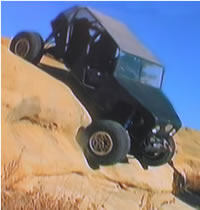 The first SRATS were completed last year (2006) as ‘proof of principle’ vehicles for the US Defense Advanced Research Projects Agency (DARPA), creating much interest among special forces. The military was ready to order over 100 of them, but then interest expanded beyond the special forces, and the Army’s Rapid Equipping Force (REF) is now interested in producing thousands of these vehicles. This potential motivated the SRATS developer to approach BAE Systems to team for the development and production of a new armored version.
The first SRATS were completed last year (2006) as ‘proof of principle’ vehicles for the US Defense Advanced Research Projects Agency (DARPA), creating much interest among special forces. The military was ready to order over 100 of them, but then interest expanded beyond the special forces, and the Army’s Rapid Equipping Force (REF) is now interested in producing thousands of these vehicles. This potential motivated the SRATS developer to approach BAE Systems to team for the development and production of a new armored version.
The armored SRATS is designed to bridge the gap between the current HMMWV and the dismounted soldier, providing support and logistics for small infantry elements, negotiate on and off-road convoy escort and mobility, carry out stealth recce missions, extract high value assets from difficult locations and conduct fast pursuit off and on-road. SRATS has a length of 175″ (4.445 m’) and wheel base of 132″ (3.352 m’), the vehicle curb weight is about 6,500 lbs (2.948 t.) for the unarmored version and 8,500 lbs (3.856 t.) for the armored vehicle, fitted with small-arms protection (7.62mm) and runflat tires. In both configurations, SRATS can carry a payload of 4,000 lbs (1.814 t.) including four passengers. The vehicle is powered by AM General 6.5 V8 turbo diesel engine rated at 300 hp and 505 lb/ft torque. It uses standard fuel tanks to sustain operation at a range of 375 miles (60- km) or accommodate larger fuel tanks for extended range.
Littoral Combat Ship – Independence Class

The U.S. Navy officially accepted delivery of the future USS Independence (LCS 2) Dec. 18, 2009 at the Austal shipyard in Mobile, Alabama. The ship will be commissioned on January 16 and is expected to be ready for ‘Sail Away’ status by February 2010.
Prior to delivery, the Navy’s Board of Inspection and Survey (INSURV) conducted Acceptance Trials aboard LCS 2 on Nov. 13-19, and found the ship’s propulsion plant, sea-keeping and self-defense performance to be “commendable,” and recommended that the chief of naval operations authorize delivery of the ship following the correction or waiver of cited material deficiencies.

Before the Navy inspection the second Littoral Combat Ship (LCS 2) Independence successfully completed the builder’s sea trials test series following a series of demonstrations performed while cruising in the Gulf of Mexico at moderate and high sea state conditions. These trials were testing the ship and all of its systems in preparation for final inspection by the Navy before delivery.
The Littoral Combat Ship is a key element of the Navy’s plan to address asymmetric threats of the twenty-first century. Intended to operate in coastal areas of the globe, the ship will be fast, highly maneuverable and geared to supporting mine detection/elimination, anti-submarine warfare and anti-surface warfare, particularly against small surface craft.
The new 127 meter long Independence Class LCS will provide a platform for intelligence gathering, employ surface (anti-ship) and land attacks precision weapons, and operate manned and unmanned aerial and surface vehicles (UAV/USV). To further adapt for specific missions, LCS will incorporate a modular and interchangeable approach, enabling it to be reconfigured to specific missions such as antisubmarine warfare, mine warfare, or surface warfare missions on an as-needed basis. The LCS will be able to swap out mission packages pier-side in a matter of hours, adapting as the tactical situation demands. These ships will also feature advanced networking capability to share tactical information with other Navy aircraft, ships, submarines and joint units.
The Independence Class LCS, built by General Dynamics is designed to offer the largest usable payload volumes per ton of ship displacement of any U.S. Navy surface combatant afloat today — providing the flexibility to carry out one mission while a separate mission module is in reserve. Its large flight deck sits high above the water, sized to support near-simultaneous operation of two SH-60 helicopters or multiple unmanned vehicles. In addition, the deck is suitable for landing the much-larger H-53 helicopters, should that become a future requirement.
The stable trimaran hull allows for flight operations in high sea conditions. The design is based on a proven Austal (Henderson, Australia) high-speed trimaran hull that is currently operating at sea.
Independence LCS-2 Demonstrates its Performance during Sea Trials
The second Littoral Combat Ship (LCS 2) Independence successfully completed the builder’s sea trials test series following a series of demonstrations performed while cruising in the Gulf of Mexico at moderate and high sea state conditions. These trials were testing the ship and all of its systems in preparation for final inspection by the Navy before delivery. Despite the weather, the ship repeatedly reached speeds of over 45 knots with propulsion and ride-control systems operating in full automatic mode, proving the effectiveness of the control systems and the highly efficient and stable characteristics of the trimaran hull form. Sustained high speed performance was part of the Navy’s requirements and the Independence demonstrated that sailing at a speed of 44 knots during the required four-hour full-power run, peaking at 45 kt maximum speed.
A series of high speed ahead and astern maneuvers in these sea state conditions proved the effectiveness of the ship’s four steerable water jets. During the repeated high-speed turns the ship demonstrated excellent agility and stability characteristics. The ship’s flight deck remained stable despite sea state conditions and maneuvers.
Another important element being demonstrated during these trials was the Open Architecture Computing Infrastructure (OPEN CI) – a highly flexible information-technology backbone that integrates the ship’s combat, damage control, engineering control, mission package and other onboard computing functions, also proved its effectiveness during the trials. This architecture enables the crew to operate consoles and workstations anywhere on the vessel. If required, the entire bridge area can be reconfigured to meet specific mission requirement, support distributed operations on board or reconfigured to recover from combat damage. OPEN CI design, developed and integrated by a General Dynamics Advanced Information Systems team, allows “plug and play” integration of both the core systems and the LCS mission modules. It meets Navy open architecture requirements, strictly adheres to published industry standards and facilitates the integration of commercially available products.
The Littoral Combat Ship is a major part of the Navy’s plan to address asymmetric threats in the 21st century. Intended to operate in coastal areas, the ships will be fast, highly maneuverable and equipped to support mine detection/elimination, anti-submarine warfare and anti-surface warfare mission.
General Dynamics Bath Iron Works is the prime contractor for the General Dynamics Littoral Combat Ship Team. Partners include Austal USA (Mobile, AL); BAE Systems (Rockville, MD); General Dynamics Advanced Information Systems (Fairfax, Va.); L3 Communications Marine Systems (Leesburg, VA); Maritime Applied Physics Corporation (Baltimore, MD); and Northrop Grumman Electronic Systems (Baltimore, MD).
On December 8, 2006 the US Navy awarded the team a US$208 million contract for the construction of the second Independence class LCS, The first ship is under construction at at Austal USA in Mobile, Alabama. Construction of the second ship of this class has begun on December 2009 with the keel laying ceremony of the Independence sister ship – Coronado (LCS-4), shceduled for delivery by in June 2012.
LEAPP – Long Endurance Autonomous Powered Paraglider / Altair
A concept for a Long Endurance Autonomous Powered Paraglider (LEAPP) is developed under a DARPA program demonstrating a cost effective alternative for fixed wing, long endurance loitering ISR capability. The system is developed by Altair. LEAPP was unveiled at the International Special Operations Forces Week this year, and was shown at AUSA 2006 in its full configuration. The parafoil system will be capable of loitering over an area for periods of up to 48 hours.
Altair is considering LEAPP to address various missions with three categories. The largest version will be a slow flying long endurance platform, which could accommodate two men, and be ground transported by a HMMWV. The system will use the largest paraglider wing ever built, spanning over 112 ft. (34 m’) The vehicle will be able to take off from a ground clearing of 50 – 100 ft (15 – 30 m’) or air dropped from C-130 or C-17 from an altitude of 35,000 ft. (10.5 km). LEAPP will be able to stay on a mission for 48 hours and carry mission payloads of up to 200 lbs, in addition to 2,145 lbs (972 kg) of fuel.
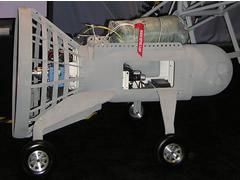 A smaller version (LEAPP Type II) will be optimized for shorter missions (u to 24 hours). It will have a gross maximum takeoff of 1,550 lbs (703 kg), compared to 3,000 (1.4 tons) for Type I. It will also be operated aspiloted/pilotless autonomous, and will be able to carry 200 lbs (90.7 kg) of mission payload but significantly less fuel.
A smaller version (LEAPP Type II) will be optimized for shorter missions (u to 24 hours). It will have a gross maximum takeoff of 1,550 lbs (703 kg), compared to 3,000 (1.4 tons) for Type I. It will also be operated aspiloted/pilotless autonomous, and will be able to carry 200 lbs (90.7 kg) of mission payload but significantly less fuel.
The Micro LEAPP (Type III) is a much smaller vehicle, with a maximum gross weight of 75 lbs (34 kg), it will have a payload capacity of 30 lbs (13.6 kg), and mission endurance of four hours. The vehicle can be launched and operated by a single operator. For takeoff, Micro LEAPP requires only 5 – 10 meters of clear surface.
Astrium Demonstrates Air-Sat Lasercom Link
In Early December 2006 EADS Astrium conducted a first demonstration utilizing high capacity electro-optical (laser) datalinks connecting geostationary communications satellites and airborne platforms.
The tests involved the establishment of six two-way optical links between a Mystère 20 aircraft, flying at altitudes of 6,000 and 10,000 m’ and the ARTEMIS satellite, orbiting the earth I a geostationary orbit, 40,000 km above the earth’s surface.
The tests were executed as part of an airborne laser optical link (LOLA), a basic study program conducted by the French defense procurement agency (DGA). The test demonstrated link lock obtained at less than one second, and pointing accuracy of the order of 0.5 microrad. The laser data rate between aircraft and satellite achieved so far is 50 Mbps. LOLA offers over x15 improvement in efficiency, compared to microwave links used on aircraft or UAVs. An inherent advantage of the laser beam is its discrete operation and immunity to jamming.
ATACMS – Army Tactical Missile System
 The Army Tactical Missile System (ATACMS) is fielded with the US Army as a deep strike precision weapon, capable of engaging time critical targets at high precision under all weather conditions. The missile is deployed from the Multiple Launch Rocket System (MLRS) family of launchers, including the MLRS M270A1 launcher and the High Mobility Artillery Rocket System (HIMARS) launcher. The US Army fired over 100 ATACMS missiles in Iraq, since Operation Iraqi Freedom in 2003, Most missiles were expended against air defense targets and C4ISR nodes. Even against a sophisticated enemy, equipped with early warning capabilities, ATACMS can maintain an element of surprise, due to its capability to launch attacks off axis. (shaping the ballistic trajectory to ‘hide’ the objective and target it is aimed at).
The Army Tactical Missile System (ATACMS) is fielded with the US Army as a deep strike precision weapon, capable of engaging time critical targets at high precision under all weather conditions. The missile is deployed from the Multiple Launch Rocket System (MLRS) family of launchers, including the MLRS M270A1 launcher and the High Mobility Artillery Rocket System (HIMARS) launcher. The US Army fired over 100 ATACMS missiles in Iraq, since Operation Iraqi Freedom in 2003, Most missiles were expended against air defense targets and C4ISR nodes. Even against a sophisticated enemy, equipped with early warning capabilities, ATACMS can maintain an element of surprise, due to its capability to launch attacks off axis. (shaping the ballistic trajectory to ‘hide’ the objective and target it is aimed at).
 The Army Tactical Missile System (ATACMS)’s Universal Dispenser is capable of delivering various types submunitions from a single dispenser foundation. These systems include radial, aft and spinning dispense in single, staggered and multiple dispense options at subsonic and supersonic velocities. Missiles and Fire Control has extensive experience dispensing Dual-Purpose Improved Conventional Munition (DPICM), Anti-Personnel/Anti-Materiel (APAM), Sense and Destroy Armor (SADARM) and Northrop Grumman’s Brilliant Anti-Armor (BAT) submunitions in subsonic and supersonic dispense environments. Lockheed Martin Missiles and Fire Control has studied several candidate submunitions for the Universal Dispenser. These include the Low Cost Autonomous Attack System (LOCAAS), SADARM, BAT, Wide-Area Munition (WAM), SMArt155 and BLU-108. In the four-quadrant configuration, the Universal Dispenser can carry four LOCAAS submunitions, 32 SADARMs or skeet warheads (BLU-108), eight BATs or 16 WAM submunitions. Integration of alternate submunitions, both domestic and foreign, will provide future growth opportunities for the ATACMS Universal Dispenser.
The Army Tactical Missile System (ATACMS)’s Universal Dispenser is capable of delivering various types submunitions from a single dispenser foundation. These systems include radial, aft and spinning dispense in single, staggered and multiple dispense options at subsonic and supersonic velocities. Missiles and Fire Control has extensive experience dispensing Dual-Purpose Improved Conventional Munition (DPICM), Anti-Personnel/Anti-Materiel (APAM), Sense and Destroy Armor (SADARM) and Northrop Grumman’s Brilliant Anti-Armor (BAT) submunitions in subsonic and supersonic dispense environments. Lockheed Martin Missiles and Fire Control has studied several candidate submunitions for the Universal Dispenser. These include the Low Cost Autonomous Attack System (LOCAAS), SADARM, BAT, Wide-Area Munition (WAM), SMArt155 and BLU-108. In the four-quadrant configuration, the Universal Dispenser can carry four LOCAAS submunitions, 32 SADARMs or skeet warheads (BLU-108), eight BATs or 16 WAM submunitions. Integration of alternate submunitions, both domestic and foreign, will provide future growth opportunities for the ATACMS Universal Dispenser.
Block 1A Unitary Missile warhead is the latest addition to the ATACMS family of munitions. This variant is designed to launch precision attack under all weather conditions, from ranges of 300 kilometers. The missile has a unique “vertical impact” capability, designed to improve penetration and optimize fragmentation coverage while reducing collateral damage. In October 2006 the US Army ordered a first batch of Block 1A Unitary Warhead missiles to replenish its tactical missile stocks, under US$47 million contract awarded to Lockheed Martin.
An enhanced version of Army Tactical Missile System (Army TACMS) specially designed for deep penetration strikes is also underway. This weapon will be optimized for the attack of deeply buried targets, such as command posts and weapons of mass destruction (WMD) storage caches. The two-stage weapon, developed by the U.S. Navy will utilize exoatmospheric transition to augment speed. Despite the devastation it creates underground, the weapon’s effect will be localized to around 328 ft (100 m’) from the impact point.
What is really behind Putin’s unprecedented hop to Tehran?
Israel’s Prime Minister Ehud Olmert arrived in Moscow Thursday on an abrupt blitz-visit. In reality, however, what exactly was the highlight of Olmert’s intercourse with Russia’s president Vladimir Putin? Was it Israel’s growing concern over Iran’s nuclear ambitions, or something else? Of interest is that no more than a day passed from announcing the trip of Israel’s prime minister to Moscow and the actual meeting of Olmert and Putin, which is by far not the common practice in interstate relations. Was it not by strange coincidence that the two leaders shook hands just in two days after Russia’s president visited Iran’s President Mahmoud Ahmadinejad and Iran’s spiritual leader Ayatollah Ali Khamenei, both arch-enemies of Israel.
For 25 years the Islamic Republic leadership in Tehran has done all it could to host such a visit with no success. Both Mikhail Gorbachev and Boris Yeltsin politely turned down Iranian invitations. Putin himself had pursued a similar policy until last Tuesday. During the summit of the so-called Shanghai Group, Putin ignored President Mahmoud Ahmadinejad’s call for a tête-à-tête. Then why the sudden change of mind, which is rather exclusive in the Kremlin’s policy?
 Indeed, the big question is why has Putin decided to visit Tehran at this time?
Indeed, the big question is why has Putin decided to visit Tehran at this time?
The answer could be simple, but at the same time very complicated: Unofficial news leaking out of Tehran’s inner circles indicate that the military brass there are very dismayed at how ineffective their newly purchased Russian air defense systems were during Israels mysterious September 6th air strike on an alleged Syrian weapons development facility near the Iraqi border. According to reports, Syria took delivery last August of 10 batteries of sophisticated Russian Pantsyr-S1E air defense missile system and fire control systems with advanced radar. Same reports indicated that some of these systems were already operational by September. Unconfirmed reports even indicated that Iran has sent some of the newly acquired Tor M1 9M330 Air Defense Systems to Syria. This would make the mystery even more painful to Moscow. As for the alleged target, which was, or was not attacked, its nature seems totally insignificant in face of the turmoil that Israel’s raid created over Russia’s precious air defenses – the repercussions of which could by far be more catastrophic for Moscow’s ambitious arms sales outlook.

Having returned without a single loss must clearly demonstrate to both Damascus and Tehran that the failure of the expensive new Russian anti-air system leaves them highly vulnerable to attack. Russian defense firms claim that Pantsyr creates an uninterrupted engagement zone of 18 to 20 km in range and of up to 10 km in altitude. Immunity to jamming is promised via multimode, multi-spectral radar and electro-optical control system. But apparently the Israelis were able to blind these systems electronically by some highly sophisticated ECM equipment. Syria isn’t saying anything, nor are the Israelis, but Iranian officers are complaining openly that they have been “fooled” by the Russians.

And the Russians were indeed reacting fast. A report coming out of Moscow, on September 27, indicated that Russia is sending top specialists to upgrade the electronics of their air defense systems. Even that will not have satisfied the Iranian and Syrian clients and only a personal intervention of Moscow’s top man- no less than Vladimir Putin himself – was urgently required to pacify the suspicious military. Having lost their confidence in the Russian weapons and this, not for the first time as past performance demonstrated dramatically, it would need all of Moscow’s persuasive powers to avert a disaster. The Russians would like to present their systems as on par with US made weapons systems, but the Israeli incursion into Syria’s defended airspace, with no Israeli jets downed demonstrated once again that Russian-made weapon systems, barring a few exceptions, are still not up to par with the West.
The reason for Moscow’s concern is understandable. In April 2006 Putin declared Russia’s arms sales surpassing 6 billion US$, some 25% above planned. Multi-year contracts in-hand were already 18 bio. 80% of all sales were to China and India, but Syria and Iran are becoming major clients for Russian arms sales, with already scores of Russian experts in Syria upgrading tanks, missiles and air defenses. A billion dollar arms deal with Tehran was signed only recently for the supply of SA-10 and Tor-M1 systems. Now Iranian officials are questioning this expensive deal, following Israel’s mysterious air incursion into Syria. Putin’s visit to Tehran must have placed this issue on top of his agenda, trying to reassure his clients in Asia that Moscow would quickly redress any shortcomings with new and more sophisticated solutions. Whether his efforts were successful remains to be seen.
The visit of Israel’s Premier to Moscow had actually been agreed on October 10, during the telephone conversation between the two leaders. But the information was a top secret, as Moscow avoided advertising the mini-summit not to cloud Putin’s visit to Tehran. President Vladimir Putin bent over backward to welcome Israeli Prime Minister Ehud Olmert to Moscow on Wednesday but cleverly denied him, what Olmert really wanted to discuss: Iran’s nuclear ambitions. Putin had every reason to do so. His forced tête-à-tête with the Tehran leaders must have cost him quite a lot of concessions in the way of Iran’s nuclear ambitions, details of which the Russian leader certainly would not be willing to share with his Israeli visitor.
In fact Prime Minister Ehud Olmert said Wednesday, before his Moscow visit, that Israel will not allow a situation in which Iran gains access to unconventional weapons and warned Iranians to “be afraid.”
“I will not address sensitive issues, if we will do this or do that, but the Iranians should be afraid,” Olmert told reporters following his meeting with Russian President Vladimir Putin and Defense Minister Sergei Ivanov in Moscow. While Olmert did not elaborate, his former security advisor and Mossad chief Ephraim Halevi was more direct. Reassuring his listeners that Israel would not be destroyed, Halevi said “We cannot say that the Iranian threat is an existential threat on the State of Israel. I believe that the State of Israel cannot be eliminated. It cannot be destroyed because of things you know and because of things you can imagine.”
Meanwhile in Washington, President Bush joined Israeli Defense Minister Ehud Barak for an unplanned meeting in the office of US National Security Adviser Stephen Hadley that same Thursday, Oct. 18, while Olmert was in Moscow. The three-way meeting was expanded to an hour and pointedly centered on the Iranian nuclear issue as a rejoinder to the Olmert trip to Moscow and to indicate the President’s disapproval, if not real anger on Olmert’s unprecedented move.
A senior US source disclosed that the US Secretary of State Condoleezza Rice, while still in Jerusalem at the end of her last Middle East shuttle, voiced stern disapproval of Olmert’s planned trip to Moscow when they met last Wednesday. She advised him not to interfere in US-Russian interchanges on Iran. This even led US officials to say ( unofficially of course) ” if Olmert wants to go his own way on Iran and work with Putin, he need not come to us for help”.
In Israel itself, senior politicians also took a dim view of Olmert’s Thursday’s rush to the Kremlin. The move was regarded as not befitting the dignity of an Israeli leader. Olmert went without thorough preparation, with only a small entourage, and without the media accompanying him.
While Israel’s interest in the issue of the Iranian military nuclear program is understandable, what was not clear was the sudden sense of urgency. If Olmert’s intent was to hear from Putin, a widely known as a very shrewd and seasoned operator, what he discussed in Tehran, then it would have been wise, if not indispensable towards achieving reliable results, to prepare the visit by an in-depth intelligence briefing. But even the best intelligence service would need time to receive worthwhile information from such high level talks, held mostly in confined secrecy environment, making leaks extremely difficult. Moreover, it would have been virtually impossible to receive such a briefing within only two days, which elapsed since Putin’s Tehran visit and Olmert’s trip to Moscow.
It is true, analysts agree, that President Bush said Wednesday in a White House press conference that an Iranian nuclear bomb may lead to a third world war. However, with all due respect, such hasty trip does not serve the Israeli interest. In fact, Prime Minister Olmert’s trip to Moscow Thursday, despite the polite welcome he received in the Kremlin, was likely destined to be in vain from the start. Israel would have been better off, without it.
Distributed Common Ground System (DCGS)
The DCGS mission is to collect and process vast amounts of intelligence and imagery from manned and unmanned reconnaissance sources.
The U.S. Air Force has deployed a new intelligence sharing capability offering commanders and analysts at different locations an immediate access to each other’s intelligence imagery and services, utilizing the recently fielded Distributed Common Ground System (DCGS) Integration Backbone (DIB) provided by Lockheed Martin (NYSE:LMT). By connecting three independent and autonomous intelligence databases, located at Langley Air Force Base in Virginia, Beale Air Force Base in California, and a forward location in Europe, DIB enabled qualified users operating DGCS an access to imagery and intelligence libraries in real-time, at other Air Force sites as well as other agencies. According to Colonel Alan Tucker, Commander, 950th Electronic Systems Group, Electronic Systems Center at Hanscom AFB, follow-on expansion of DIB will create a worldwide intelligence sharing enterprise, providing users with access to information portals offering immediate access to more than 80 percent of the imagery produced.
Prior to the development of the DIB, intelligence analysts had to visit multiple collection sources to locate the data needed. By incorporating a set of common interface standards and a Service-Oriented Architecture (SOA), the DIB connects disparate locations and allows analysts with the appropriate security clearance to access a multitude of intelligence sources. Being SOA-based also facilitates the interface with other SOA-based systems and assures the continuous evolution of a web of capabilities.
Currently deployed DCGS version 10.2 was fielded with U.S. Air Force elements in USA and Middle East Theater in 2006. A similar system is now under development for the U.S. Army. DCGS integrates multiple ISR sensors and systems across the battlefield, drawing intelligence data from various sources, and correlates that data into an integrated picture of the battlespace. The DCGS-A (Army) will extend this capability to ground elements. It will be deployed with fixed sites as well as forward, tactical and deployed forces, including units on-the-move. DCGA-A will integrate threat, terrain and weather data into comprehensive intelligence products, utilizing sensors data, intelligence and analyst resources available in the rear and at the forward area, increasing the capacity and quality of intelligence products while minimizing the forward footprint of ISR.
Multi Vehicle Control System (MVCS)
Raytheon promotes its new Multi Vehicle UAV Control System (MVCS) for the control of multiple, dissimilar unmanned vehicles. Providing the user interface and control of unmanned systems, MVCS Core UAV Control System (CUCS) complies with STANAG 4586 as well as the Joint Architecture for Unmanned Systems (JAUS), to manage all tasks involved with the mission, including vehicle tasking, system monitoring, mission and route control, waypoint planning and payload tasking, receipt and dissemination.
The modular design using software ‘plug-in’ interfaces allowing high flexibility in user interface design and functionality to be tailored based on customer needs, operator preference, vehicle and payload capabilities and requirements. Vehicle Specific Modules (VSM) are developed for the control of specific platforms. Each VSM represents the unique capabilities of the vehicle. Existing plug-ins include mapping and mission planning, flight displays, vehicle status panels, digital video displays and advanced payload displays. VSMs are provided for Silver Fox, Manta, Cobra and raven UAVs and the US Navy’s USSV unmanned surface vehicle.
MVCS runs on open Java/J2EE environment and, therefore, adapts to various operating systems and platforms, including Windows, Sun Solaris, Apple Mac OS X and multiple Linux flavors. Adapted to web–based service oriented architectures (SOA) it can easily interface with the joint Distributed Common Ground System (DGCS) intelligence distribution system. MVCS is designed for implementation on various hardware platforms, from small handheld systems, supporting special operations through laptop-based vehicular systems to desktop and workstation based systems used in command centers.
MQ-5B Hunter UAV
Northrop Grumman Corporation’s (NYSE:NOC) Hunter Unmanned Aircraft System (UAS), in use with the U.S. Army since 1996, recently surpassed 50,000 flight hours in service, over half of which were flown in combat over Iraq and the former Yugoslavia. Northrop Grumman-operated Hunter MQ-5A and Army-operated MQ-5B models are currently deployed in the Global War on Terrorism. Hunter provides warfighters with state-of-the-art reconnaissance, surveillance, target acquisition (RSTA), communications relay, and weapons delivery. Hunter is currently operated by the US, French and Belgian armies.
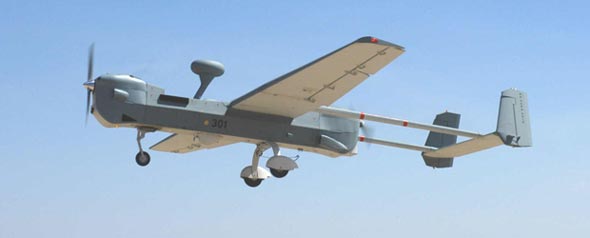
The RQ-5A Hunter was the Army’s first fielded UAS. Hunter is capable of covering ranges of 125 to 250 km utilizing air data relay. Flying typical missions at 70 kts, with occasional dashes, Hunter’s endurance was increased from 12 hours to 21 hours, with the introduction of wet extended center wing and new Heavy Fuel Engines (HFE, using diesel or jet fuel) (see below).
Currently deployed with aerial exploitation companies in support to III corps, XVIII Airborne Corps and V corps, Hunter was the first UAV in US Army inventory to demonstrate weapons capability. In 2003 Hunter was tested with acoustic/IR homing BAT weapon, as well as a modified laser designated BAT, called Viper Strike. In 2004 the Hunter’s engines were replaced from the two-stroke MotoGuzzi gasoline engine to a three cylinder commercial JP-8 fuel engines. This heavy fuel engine improves performance and simplifies the logistics and support of the system in the field. A Hunter UAV system includes three ground control stations, two ground data terminals, six Hunter aerial vehicles and six IAI/Tamam MOSP EO/IR day/night payloads, offering imagery with focal length of 280mm up to 770mm. Three airborne relay datalinks are employed by the unit for extended range operations.
The MQ-5B is the advanced version of the system enhanced with a modern avionics suite, heavy fuel engines, and inclusion of “wet” (fuel-carrying) extended center wing and introduction of weapons-capable hard points. The MQ-5B Hunter system uses the US Army’s ‘One System’ ground control station and remote video terminal. It also carries a communications relay package to extend the radio range of warfighters. A differential GPS automatic takeoff and landing system is under development for Hunter. The MQ-5B can carry two Viper Strike munitions on a 16 hours mission.
The aircraft features a robust, fixed-wing, twin tail-boom design with redundant control systems powered by two heavy fuel engines – one engine to “push” and another to “pull” the air vehicle. A unique Hunter capability is its relay mode that allows one Hunter to be controlled by another UAV at extended ranges or over terrain obstacles typical of those found in the Balkans and Afghanistan.
To replace obsolete systems, increase readiness and reduce the logistics burden on soldiers, Northrop Grumman integrated a new suite of avionics for Hunter, including upgraded flight and mission computers, an auxiliary power distribution unit, the LN-251 inertial navigation system and GPS units, a downsized data link system, and an APX-118 IFF transponder. The avionics suite improves performance by reducing size, weight, and power consumption of the equipment used to control the aircraft and manage its critical subsystems.
In 2006 the Hunter was used to test an Adaptive Joint Intelligence payload – a new reconfigurable payload that will allow users to share multiple types of communications simultaneously; a capability that is not yet available to warfighters in the field. The software-driven payload will be reconfigurable to operate as a communications relay, a signals intelligence-gathering device or an electronic-warfare tool.
Further enhancements were demonstrated by the E-Hunter program, utilizing a 54.5 foot wing and a new tail assembly, both derived from the Hunter II aerial vehicle. The Northrop-Grumman’s Hunter II proposal for the ER/MP program was based on an enlarged variant of the Hunter UAV, leveraging modern avionics from MQ-5B Hunter system. Eventually, the US Army selected the Sky warrior – proposed by General Atomics. With the HFE engine, E-Hunter could take off at a maximum weight of 2,200 lbs, on a 40 hours mission at a ceiling of up to 25,000′. The new wings and tail are designed to carry a variety of external sensors, communications, EW and weapons payloads. E-Hunter was flown for the first time on March 17, 2005. as part of an on-going cooperative effort between Northrop Grumman and the US Army, to extend the range, endurance and payload capacity of the Hunter UAV system. The modification will be offered as a field installable kit.
ROVER III Remote Video Terminal for One System GCS
Remote Optical Video Enhanced Receiver (ROVER) III was originally developed for the U.S. Air Force. The Rover III provides front line forces the capability to receive imagery directly from unmanned and manned aircraft. The Army, using the Rover III as the building block, planned to the existing inventory of legacy Remote Video Terminals (RVT) introducing a system compatible with the One System ground control system (GCS). The system produced by AAI corp. provides the same capability as the Rover III and the ability to overlay UAS telemetry directly on a moving map for improved situational awareness and targeting.
The new device enables users on the ground to receive information from remote sources using both analog L and C bands as well ad digital C band data-links. Further enhancements include the capability to interpret proprietary metadata, transmitted on many Unmanned Aerial Sensor (UAS) platforms.
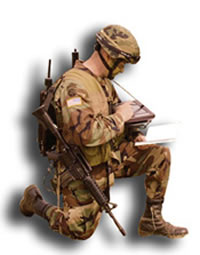 The CK-45 transciever, developed by L3 Communications supports three bands receive and C or Ku band for transmit, transferring up to 45 mb/sec data rate. The system enables ground elements, vehicular or dismounted, to share overhead imagery (sensor video) on the move, from various airborne sensors, such as helicopters, fighter aircraft and unmanned platforms. A rugged, manpack Rover III system supports reception over three bands – C, L and Ku, receiving sensor video and data from airborne sources. When employed with an omni-directional antenna, the system weighs only 12 lbs and can operate for 10 hours from a BA-5590 battery. Rover III receives sensor data from the Predator, Shadow 2000, Hunter, Fire Scout, Pointer, Dragon Eye and raven.
The CK-45 transciever, developed by L3 Communications supports three bands receive and C or Ku band for transmit, transferring up to 45 mb/sec data rate. The system enables ground elements, vehicular or dismounted, to share overhead imagery (sensor video) on the move, from various airborne sensors, such as helicopters, fighter aircraft and unmanned platforms. A rugged, manpack Rover III system supports reception over three bands – C, L and Ku, receiving sensor video and data from airborne sources. When employed with an omni-directional antenna, the system weighs only 12 lbs and can operate for 10 hours from a BA-5590 battery. Rover III receives sensor data from the Predator, Shadow 2000, Hunter, Fire Scout, Pointer, Dragon Eye and raven.
One System Remote Video Terminal (OSRVT) is currently produced in Block I configuration, offering receive only operating mode. It is a small, portable receiver and display system integrating live video and telemetry data from an array of manned and unmanned aircraft systems, including Shadow, Predator, I- GNAT, Raven, Pioneer, and Hunter. The system can receive and display video, data, and annotated maps improving the field commander’s situational understanding and decision making process. Video data is received with geo-location information. Video “footprint” and icons can be used to identify aggressor units, vehicles, facilities, and natural landscape features overlaid on a geo-location map, enabling swift target identification, decision making, and response. The basic system enables video reception within line of sight. The system’s extended-range antennas enable the OSRVT systems to meet mission range requirements with reception up to 80 kilometers.
On 25 October 2006 AAI Corporation announced it will deliver to the U.S. Army 51 remote video terminals (OSRVTs) and 38 extended- range antennas at a cost of US$3.9 million. On November 13, 2006 L-3 Communications announced it began shipping ROVER III data links. Follow-on systems, planned for FY08 and beyond, will consist of Block 2 OSRVT versions which will also enable active control of the payload. The Block 2 OSRVT will be fielded initially to the Shadow UAV Platoons and could potentially become the Ground Control equipment for the Small UAS.
G-MLRS Guided Rocket System
Guided-Multiple Launch Rocket System (M30)
The Multiple Launch Rocket System (MLRS) M-270A1 program was developed and produced as a multinational program since 1976. The original partners (France, Germany, Italy, the UK and USA) continued the cooperation into the current Guided MLRS (GMLRS) program, which pursue more accurate guided rockets using fewer rockets to achieve the effect while reducing collateral damage. Each GMLRS is equipped with a GPS/IMU guidance system and small canards installed on the rocket’s nose to provide basic maneuverability and enhance accuracy. The latest version of GMLRS will be equipped with a unitary warhead, to further reduce collateral damage (generally associated with scatterable munitions). GMLRS completed development in 2001 and since 2005 is in full rate production for the US forces. The US Army is planning to procure more than 100,000 GMLRS rockets. The new rocket has a range of more than 70km. Lockheed Martin is currently producing Block 1A missiles to replenish depleted stocks, under a US$47 million order by the U.S. Army. In December 2006 Lockheed Martin received additional $78 million for GMLRS production in 2007.
The current GMLRS warhead uses a cargo of 404 Dual Purpose Improved Conventional Munition (DPICM) bomblets. The development of a 180 pound unitary warhead is in progress. Several versions of multi-effect warheads are currently considered by the US forces and other MLRS users.
One result of Dual Purpose Improved Conventional Munitions (DPICM) inefficiencies was the urgent requirement set by the U.S. Army, for 496 guided Multi-Launch Rocket Systen (G-MLRS) rockets carrying a unitary warhead developed by General Dynamics. The unitary warhead is currently in the system design and development phase, which will continue through 2007. General Dynamics will also supply these warheads until year 2020, under a contract awarded by the US Army in July 2006. The warhead uses a tri-modal fuse, enabling airburst, point and delay activation. Airburst effectively covers wide area with more focused footprint and, compared with DPICM loaded MLRS, it is more accurate and leaves a clean battlefield after the attack. Delay activation enables effective penetration of rooftops and structures, improving effectiveness and reducing collateral damage, when employed in urban environment. When fitted with a 200 lbs (90.7 kg) unitary warhead and an inertial guidance for precision impact, G-MLRS is classified as “low collateral damage” weapon.
An advanced version of the GMLRS’ unitary warhead could use the Enhanced Blast Warhead (EBW) developed by Lockheed Martin. When exploded, this warhead creates an over-pressurization effect (similar to a thermobaric charge). This effect devastates enclosed structures but has less effect on adjacent buildings, therefore, reducing the risk of collateral damage. This version of GMLRS is designed to strike targets at a range of over 70 km. EBW will also have improved penetration capability, enabling the rocket to go through several floors of conventional buildings before exploding in the basements.
The U.S. Army used the M-30 Guided MLRS in recent combat engagements in Iraq, demonstrating devastating effect of the 196 lbs (89 kg) unitary warhead, minimal collateral damage and an element of surprise, utilizing its maximum range of 43.5 miles (70km), a combination that would not be achieved by tanks or other direct fire elements.
Another unitary warhead option is the BANG warhead, already used by the French Army. BANG uses insensitive explosives and multi-effect fuze, featuring airburst, impact and penetration modes of operation. MBDA and Aerojet are jointly proposing BANG to the five nation’s unitary warhead program. GMLRS loaded with BANG warhead was tested in 2005 as part of UK MoD evaluation. Further tests demonstrated extended range capability, firing the rocket to over 103 km using modified flight controls. Software modifications that could increase GMLRS range are incorporated as part of the future GMLRS unitary development. Further enhancements considered for the rocket are the inclusion of semi-active laser homing device.
In June 2007, the U.K. Ministry of Defence (MoD) awarded Lockheed Martin three contracts for the delivery of Guided MLRS systems. The contracts are part of an incremental, multi-year acquisition program worth more than £250 million. The current contracts include rockets, upgrade kits, spares and support, including12 MLRS M270B1 launcher upgrades and Guided Unitary rockets. The first new launchers have been delivered and training and testing of the new system and rockets is under way in the U.K. and U.S., respectively. Similar units have been in operation with the U.S. Army since 2002.
USMC Funds Production of 15 New Radars
G/ATOR – Ground/Air Task Oriented Radar
The Humvee-mounted lightweight Ground/Air Task Oriented Radar (G/ATOR) is a U.S. Marine Corps Systems Command program, designed to provide a multi-mission ground-based radar that consolidates four different radar mission areas into one system. In 2005 Northrop Grumman was selected by the USMC to develop and produce the system. The G/ATOR team also includes Sensis Corporation, CEA Technologies, Inc., Techrizon (formally Telos) and CAT Logistics.
In March 2007 Northrop Grumman (NYSE:NOC) a awarded additional $256 million contract for the first phase (Increment I) development and demonstration of the system. The funding covers the development and production of 15 systems, designed to fulfill Short range air defense and air surveillance missions. Additional 48 systems are planned for production in further increments. Further developments will introduce enhanced capabilities and address multi-mission tasks including counter fire/targeting missions and air traffic control missions.
The radar will use active electronically scanned array (AESA) technology to provide aircraft detection, tracking and engagement; cruise-missile detection and engagement; ground-weapon location; and military air-traffic control. The G/ATOR’s modular architecture allows for greater flexibility in adapting it to both existing and new logistics plans, platforms and technologies.
At the initial phase (Increment I) the system will fulfill USMC short range air defense and air surveillance requirements. The program is structured as an evolutionary acquisition consisting of four blocks of incremental development and production, referred to as Increments I through IV. Each block builds upon the capabilities of the preceding increments in an additive fashion.
Increment I supports two distinct mission areas: Short range air defense and air surveillance.
Increment II will address the Marine Expeditionary Force counter fire/targeting missions.
Increment III will incorporate tactical enhancements of the air mission requirements, including Mode 5/S identification friend or foe, decoy/electronic counter-counter measures capabilities, an advanced RES, a non-cooperative target recognition, sensor netting, and an integration data environment capability.
Increment IV will address support of air traffic control missions.
Coyote – Air Deliverable Expendable UA
 Coyote, built by Advanced Ceramics Research is designed as an air deliverable, optional expendable UAV weighing up to 6.4 kg, (14 lbs). With folded wings, propeller and tail, it fits into a standard A-size sonobuoy container. After release from its container, Coyote can dive to lower altitude, using its vertical fins as control and stabilizing surfaces.
Coyote, built by Advanced Ceramics Research is designed as an air deliverable, optional expendable UAV weighing up to 6.4 kg, (14 lbs). With folded wings, propeller and tail, it fits into a standard A-size sonobuoy container. After release from its container, Coyote can dive to lower altitude, using its vertical fins as control and stabilizing surfaces.
As it reaches its cruising level (about 500 – 1200 feet above the surface), the wings are expanded over their full span (1.47 meter) and electrical motor started, preparing the aircraft for its mission. It can cruise at a speed of 111-139 km/h (60 – 75 kt) or loiter at 102 km/h (55 knots) for up to 60 minutes. Coyote is equipped with an electro-optical payload comprising a video camera with 10x optical zoom, and 320×240 pixel microbolometer. The payload transmits video in real time over a range of 37 km (20 nm) using 2 watt S-band transmitter.


